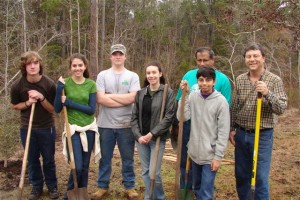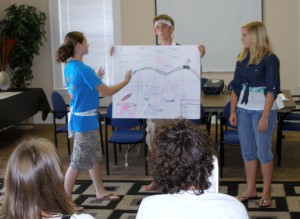by Heather Kent | Oct 3, 2014
 4-H Meetings should be fun for both the members and the volunteers. Club environments that cultivate belonging, mastery, independence, and generosity. Leading a 4-H club should be a fun and rewarding experience. Earlier this month, during our Make a Difference Monday Volunteer Leader Series, Tycee Prevatt shared some simple, but creative ideas to make club meetings fun, but also more manageable!
4-H Meetings should be fun for both the members and the volunteers. Club environments that cultivate belonging, mastery, independence, and generosity. Leading a 4-H club should be a fun and rewarding experience. Earlier this month, during our Make a Difference Monday Volunteer Leader Series, Tycee Prevatt shared some simple, but creative ideas to make club meetings fun, but also more manageable!
Divide your club into teams of 3-5 youth. Assign an older 4-Her (intermediate or teen) to serve as the team leader. This will not only make your club more manageable, but it also fosters leadership, teamwork, and cooperation- three essential skills for a happy and productive life.
How this works:
- Assign each team a color (buy inexpensive plastic tablecloths at the dollar store in each team color).
- Teams sit together during club meetings/functions. Parents sit behind the teams so as not to interfere.
- Teams can earn points for: attendance, being prepared for club meetings, being on time, doing a club demonstration, participating in a club service project, and attending 4-H events and activities beyond the club level (such as a day camp or canning workshop).
- As the leader, you can also use “pop quizzes” or project skill a thons to allow more opportunities to collect points. Parent can help with the skill a thon stations and your 4-H agent can help you set up a skill a thon. Stations can be project specific, such as naming the parts of a saddle, or they can be more general, such as reciting the 4-H pledge from memory or answering 4-H trivia questions.
It is important to set up a points system before introducing this to the club. This idea is really easy to adapt to any club situation. This example of a club points system is from a livestock club.
You will also need to decide on appropriate incentives. Some clubs give out a grand prize to the top team, others give prizes for 1st, 2nd, and 3rd teams. Ideas include: partial scholarships to 4-H camp, cash award, pizza or bowling party, or a fun field trip related to their project. Your club may need to do some fundraising to help pay for the prizes.
The team approach works well because it really encourages the members to attend the meetings on time and prepared. It helps motivate them to become more engaged. You will also have fewer interruptions or discipline issues, because teams can lose points for that! This approach works particularly well for medium to large clubs and can even be adapted for use during camp.
What are your best tips for making meetings fun? Let us know in the comment box below. Also, make plans to join us on October 20th for Make a Difference Monday at 7/6 central. Dr. Dale Pracht will be sharing how to create safe environments in our 4-H clubs. If you cannot make our live presentation, it will be archived along with this month’s presentation at http://florida4h.org/madmondays.
by Heather Kent | Aug 29, 2014
It’s that time of year again- time to re-enroll in 4-H! All volunteer and member profiles were set to inactive on August 23rd, so in order to be a member or volunteer this year you will need to re-enroll. The online enrollment system that we use is called Florida 4-H Online and can be accessed at http://florida.4honline.com . To re-enroll, you will need access to a computer and the internet. If you do not have access at home, you can visit your local library or Extension office. Many offices will have a kiosk set up in their lobby this time of year so that volunteers and members can quickly stop by and complete the re-enrollment process.
If you were a volunteer or member last year, you will just need to update your profile. If you forgot your family login, contact your extension office and they can re-set it for you. Be sure to enter any changes to your contact information or health form. Members will also need to select a club and project for the year. If you are a volunteer, and it has been at least 5 years since you were screened, you will be asked to complete the application and screening process again. The level of screening will be determined by your level of involvement as a volunteer. Your local extension office will notify you if you need to complete a new application and screening.
If you are new to 4-H this year (or to our state), then you will need to create a new family profile, and then a profile for each family member old enough to participate in 4-H. Your first time enrolling will take a little longer, but each year after that the process is not as involved.
Club leaders may want to work with their local 4-H agent to set up a club kickoff meeting and arrange to have an enrollment kiosk set up so that parents can enroll or re-enroll their children when they drop off/pick up children from the club meeting. For step by step instructions on how to re-enroll, visit: http://florida4h.org/4honline/files/Instructions-for-4-H-Online-Enrollment.pdf. Your local extension office is also happy to help you if you have any questions. Many fall fairs, as well as state events have enrollment requirements within so many days of the event, so do not wait to re-enroll!
by Whitney Cherry | Dec 6, 2013

4-H Volunteers strive to provide safe and secure learning environments.
From time to time new laws regarding youth protection are considered by federal and/or state lawmakers. As these new laws and regulations are passed their effects are wide-felt, and often they reach into the 4-H program. One such federal regulation on youth protection was recently passed, and while the new protection that it affords our youth is much welcomed, it does mean that 4-H volunteers will be seeing some changes in their county’s volunteer screening procedures.
What are the major changes?
- All club leaders must be “435 Level 2” screened. This means you will be fingerprinted.
- All volunteers who work with youth 10 hours or more in a month, even if they are not club leaders, will be “435 Level 2 screened. This means you will be fingerprinted.
- All camp counselors will be “435 Level 2” screened.
- All volunteers working directly with youth will be “Level 1” screened regardless of the number of hours spent with youth. This means you will be background checked, but may not fingerprinted.
What can new and existing volunteers expect?
- Existing volunteers may have completed some of these steps under our former system for volunteer screening. They will be asked to complete the steps that are new. New potential volunteers will need to complete each of the following steps in order before they should work directly with youth.
- 435 Level 2 screening:
- Register in 4HOnline (http://florida.4honline.com)
- Interview with your 4-H agent (Your 4-H agent will also obtain at least two letters of reference.)
- Complete the online youth protection training (YCS800)
- Return a notarized Affidavit of Good Moral Character to your 4-H agent
- Schedule livescan finger printing (Your 4-H agent will help you with this.)
- Be finger printed for 435 Level 2 screening
- Receive a letter of appointment from your 4-H agent
- Level 1 screening
- Register in 4HOnline (http://florida.4honline.com)
- Interview with your 4-H agent (Your 4-H agent will also obtain at least two letters of reference.)
- Complete the online youth protection training (YCS800)
- Be background screened (Your 4-H agent will complete the screening.)
- Receive a letter of appointment from your 4-H agent
- The new policy also places an emphasis on accurate and timely record keeping, so your agent may require additional training on this subject.
This policy is new for agents and volunteers alike, so please be patient with your local extension office as they try to work as quickly and efficiently as possible to get all of their volunteer screenings up-to-date.
A copy of the new UF/IFAS Youth Protection Policy can be found at: http://florida4h.org/volunteers/risk_management/files/Youth_Protection.pdf*
*The official policy takes precedence over any discrepancies which may be found in this article.
by Stefanie Prevatt | Sep 13, 2013
Welcome to the new 4-H year! As you begin making plans to re-connect with your club members and families, make plans to create a year-long plan for your 4-H Club.
Why should your 4-H club plan up to a year in advance?
A plan will help to:
- Meet the needs of all members
- Share responsibilities (among youth, parents, and volunteers)
- Provide better communication to members and families
- Practice cooperation, compromise, and planning skills
- Avoid calendar conflicts

4-H members plant trees for a community service project during Arbor Day.
What should be in your 4-H club plan?
- Monthly Business Meetings
- County, District, and State Activities
- Tours and Trips
- Community Service
- Workshops
- Recreation
- Guest Speakers
- Fund Raising
There are many different ways to create a “year plan” for your 4-H club. The following are a few examples of activities that can be done during a meeting to ensure that all members’ thoughts and ideas are expressed. Keep in mind, when beginning to discuss plans for your club’s focus, education should be the top priority (what youth want to learn during the year).
Sharing Ideas:
Tape a large piece of paper to the wall. On the paper, write two statements: (1) “This year in _____ 4-H Club, I want to learn…” (2) This year in _____ 4-H Club, I really want to….” As youth arrive, direct their attention to the paper and ask them to complete the statements. At a designated time during the meeting, discuss the responses.
Collages:
Have youth create a collage of his/her “year plan” for the club. Materials needed for this activity are: magazines, newspapers, crayons, markers, scissors, glue, construction paper, etc. You can also do this activity in groups.
Design Your Own Clover
Have each member complete the “Design Your Own Clover.” Members can share one leaf of the clover a designated point during the meeting.
Creating a Program Planning Committee
Now that you have all these ideas from your club members, how do you implement your plan? Form a program planning committee. It is important that this committee be representative of your entire club. Older members are likely to be effective planners, but might leave out needs of younger members. In general, committee members are: vice president, secretary, recreation leader, and an adult. It is also good practice to add two or three members who are not officers. This committee can meet on a separate day from the club meeting or convene before/after a club meeting to complete their responsibilities. Once finalized, the committee should report back to the entire club to receive final approval for their plan.
Club planning is not a cut and dry process. Every club can modify these practices to best suite your members – keeping in mind the reason for creating such a plan is to keep the actions of your club directed toward your goals. Your 4-H Extension Agent is also a great resource during this process. Contact your local agent to receive help in creating a plan or for a list of important dates/deadlines for your local office.
Resources:
http://www.uaex.edu/other_areas/publications/PDF/4HCF1.pdf
http://gallia.osu.edu/adams/topics/4-h-youth-development/making-the-best-4-h-clubs-better-twenty-minutes-at-a-time/Handout%20-%20Design%20Your%20Own%20Clover.pdf
http://florida4h.org/clubs/files/4H%20GCL%2020.PDF
by Suzanne Wilson | Aug 16, 2013
It’s time for our 4-H clubs to start the new 4-H year. If your 4-H club took time off for the summer break the first club meeting can be a little crazy. Everyone will want to catch up and share their summer adventure stories. Why not take advantage of this excitement and make it part of a club meeting. There are several factors that will determine your options. The age of your club members, socio-economic factors, and family dynamics should all be considered. Be mindful of everyone’s family circumstances. Set ground rules so everyone is treated with respect. As the 4-H club leader, it is important for you to create an environment where your members feel safe sharing experiences and ideas.

4-H is Like a Roller Coaster
(more…)
by Sherri Kraeft | Jul 5, 2013
![1013441_659740687387883_254816366_n[1]](https://nwdistrict.ifas.ufl.edu/4hn/files/2013/06/1013441_659740687387883_254816366_n1-150x150.jpg) One word: Incentives
One word: Incentives
Youth enjoy 4-H summer camp because it provides a welcoming environment where they can learn and grow. They get to make new friends and participate in activities like, archery, swimming, canoeing, rocketry, kayaking, arts and crafts, and more. When they come home from camp singing camp songs and relating their awesome experiences, they encourage their friends at school as well as fellow club members to come with them during the next year. With this in mind, how can club leaders and other volunteers encourage youth to participate in camp if they have never attended or have never considered attending?
At this time of year, camps may already be over for your county 4-H program, but it is never too early to start planning for next summer. As club leaders, when you begin thinking about fundraising and club program planning for the fall, consider incorporating some “camp incentives” for youth who might want to plan to attend camp next year. Here are a few ideas:
- Include fundraising percentages or credits given to members who participate in and plan club fundraisers. Maybe 10% of the funds they raise for the club in a particular fundraiser will go to their camp fees, etc.
- You may offer full or partial scholarships to youth who demonstrate leadership or take on an officer role in a community club setting.
- Allow 4-H members who turn in a completed and well-produced project book to be rewarded at the awards banquet with a camp price reduction or prize to be used in conjunction with camp attendance such as a club t-shirt or goodie bag with camp related items.
While funding for camp can introduce challenges for some club members, these obstacles when handled appropriately and quickly can provide terrific learning opportunities for youth who earn their way to attend camp and have a wonderful experience while there.
 4-H Meetings should be fun for both the members and the volunteers. Club environments that cultivate belonging, mastery, independence, and generosity. Leading a 4-H club should be a fun and rewarding experience. Earlier this month, during our Make a Difference Monday Volunteer Leader Series, Tycee Prevatt shared some simple, but creative ideas to make club meetings fun, but also more manageable!
4-H Meetings should be fun for both the members and the volunteers. Club environments that cultivate belonging, mastery, independence, and generosity. Leading a 4-H club should be a fun and rewarding experience. Earlier this month, during our Make a Difference Monday Volunteer Leader Series, Tycee Prevatt shared some simple, but creative ideas to make club meetings fun, but also more manageable!



![1013441_659740687387883_254816366_n[1]](https://nwdistrict.ifas.ufl.edu/4hn/files/2013/06/1013441_659740687387883_254816366_n1-150x150.jpg)